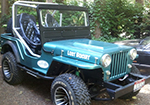Steve shared some links that provide a little history about the manufacture of WWII vehicles, including the jeep, at the Ford Assembly Plant in Richmond, California.
This first link provides information about jeep contracts and more (http://fordmotorhistory.com/factories/richmond/richmond_jeeps.php):
Assembly of jeeps at Richmond was a fairly simple process. The plant received most components from Dearborn, including the frames, which had already received a first coat of paint there. Workers placed a frame on the assembly-line conveyor and then attached springs and front and rear axle assemblies. Then they gave the entire chassis a second coat of paint. Next they installed the engine, steering gear, transmission, transfer case, battery, wheels, radiator, body, gasoline, oil, and coolant.
A Ford inspector then started the jeep for the first time and took it for a 5-mile test drive, noting deficiencies that were rectified upon return to the plant. Then Ford turned the jeep over to Ordnance for inspection and acceptance. Ordnance inspected every jeep with at least a 1-mile road test. Ten percent of the jeeps received a 5-mile test, and 1 percent received a 100-mile test. Once accepted. Ordnance returned each jeep to Ford, where it was sent it to a screen room for a radio suppression test under the supervision of an Ordnance inspector. Then Ford took the jeep to the disassembly line where it was prepared for boxing.
The workers at Richmond also did their part to send reading material to the troops abroad (http://fordmotorhistory.com/factories/richmond/richmond_jeeps.php):
Workers at the Richmond branch did more to support the troops in the field than simply do excellent work in preparing tanks and other combat vehicles for shipment abroad. They also undertook a special project aimed at bolstering the morale of soldiers on the front lines, far from home. Under the leadership of Frank Vivian, an engineer in the boiler room, members of UAW Local 560 (who called themselves the “boilerhouse gang”) collected current magazines and newspapers from members of the community, wrapped them in packages, and placed a package in each completed jeep or tank before it was sealed for shipment. By November 1944, workers at the Richmond Tank Depot had sent 40 tons of magazines, bundled and stowed in vehicles, to the troops in the theatres of war.
This next link explains that a new tank contract forced the boxing of jeeps temporarily outside (http://fordmotorhistory.com/factories/richmond/richmond_tanks.php):
The San Francisco Ordnance District received instructions from the Office of the Chief of Ordnance in May 1942 to begin the preliminary work of establishing a tank depot in the Bay Area. By then, the Richmond branch had been assembling jeeps for several months. A short time later, an officer in Washington called the Ford Motor Company to inquire about the availability of the Richmond branch to prepare tanks for shipment overseas ….. When the tank-depot contract was signed, the Richmond branch was using the craneway to box jeeps for shipment abroad. That operation had to be moved outside immediately. Shortly thereafter. Ford built a boxing shed along the east side of the plant to facilitate the crating of jeeps and other vehicles.
The article also references the known flotation issues with the GPA (SEEP) (http://fordmotorhistory.com/factories/richmond/richmond_tanks.php):
Another accident had occurred the previous month that reflected a different sort of laxity as the war drew to a close. On April 14, two Ford workers took an amphibian jeep for an unauthorized cruise in the bay while a group of the vehicles was being prepared for shipment. Ordnance and Ford managers had received instructions not to test the amphibians because they were not yet ready for travel in water, but the workers evidently had not heard or heeded the instructions. The amphibian jeep sank about 100 feet from shore in 30 feet of water. One worker swam to shore, but the other had to be rescued by some nearby Signal Corpsmen. The depot had to hire a barge and diver to locate and retrieve the jeep.
